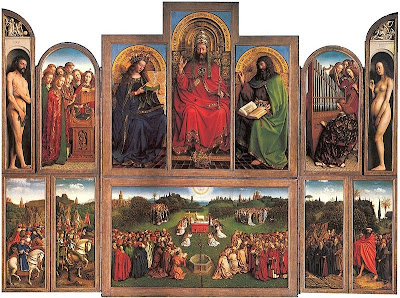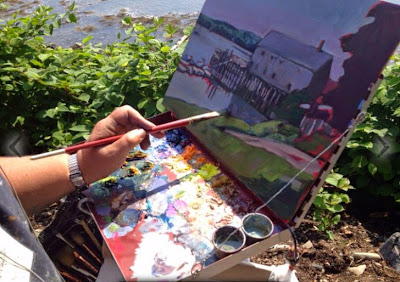 |
| Dinghy, 6X8, oil on canvasboard, Carol L. Douglas. |
A man was fishing in a small boat, not particularly doing much of anything, when one of those bumptious, officious ‘self-made man’ types wandered over to give him some advice.
“Yanno, if you put a little effort into it, you might catch something. Get yourself a sonar fish finder and an engine for that boat, and you might actually find some fish.”
“Why would I want to do that?” asked the fisherman.
“Well, this here’s great fishing country. I bet you could set up shop as a guide, take people fishing, maybe get a fleet of boats, take lots of people fishing.”
“Why would I want to do that?” asked the fisherman.
“To make money!” yelled the exasperated man.
“And why would I want to do that?” asked the fisherman.
“So you can retire and have time to fish!”
M. is a returning student for my
Sea & Sky workshop, so of course I have a vested interest in her being rested, healthy and happy by August. Sunday, she reported: “I sold one of the looms (to finish paying off the winter fuel bill for one of the apartments) and put a second coat of primer on the dormer windows on the back side of our house while my husband mowed yards. How many years till I can retire?”
Getting out of a similar grind has been my goal for several years. I find my acquisitiveness waning. I noticed it while house-hunting in Maine, when I was content to look at properties and say, “That would make a great project… for someone else.”
 |
| Sign of the times. |
If you’ve never visited a Whole Foods Market, they’re a temple to pampered dissatisfaction. I’m hardly the only person to notice this; there’s an internet meme, “Overheard in Whole Foods/Waitrose.” In a way, these stores are our culture’s temple. They sell necessities totally divorced from need. Their customers may be the punchline to a joke, but they’re really just an extreme example of a malaise we’re all prone to.
Yesterday a friend asked me how I was coping with packing. My first reaction was an old campfire song: “I’ve got that joy, joy, joy, joy, down in my heart…” And then I actually apologized for being happy. It runs against the grain in our society to admit that things are pretty good. We caution against tempting fate.
 |
| The Harbormaster’s Dinghy, 6X8, oil on canvasboard, Carol L. Douglas. |
Yes we all suffer, and I don’t mean to make light of that. But the things from which we suffer—illness, death, uncertainty—are eternal verities, and even they have been pushed back by science.
If I suggest to people that they count their blessings, they usually start and end with their loved ones. For some reason, our material blessings—our nice houses, cars, and bank accounts—aren’t generally included. But we are rich beyond most people’s wildest imaginings. We have more than any other people in the history of the world, and still we’re unhappy.
 |
| I admire beautiful things as much as the next person; I just no longer covet them. |
Like many bad behaviors, this is both sinful and self-destructive. It’s sinful because it denies God the proper credit for our blessings. It’s self-destructive because it robs us of joy.
We really could spend less time building and more time enjoying what we’ve already built.
Let me know if you’re interested in painting with me on the Schoodic Peninsula in beautiful Acadia National Park in August 2015. Click here for more information on my Maine workshops! Download a brochure here.







































